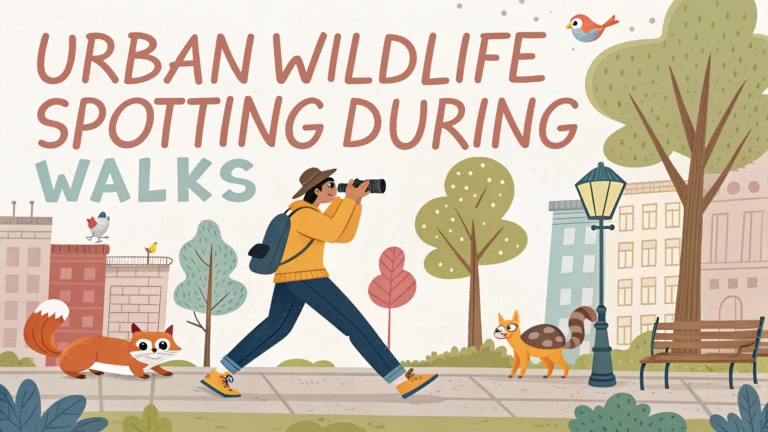Urban wildlife spotting adds excitement and natural discovery to any walking tour or casual stroll through the city.
This guide helps you spot, identify, and safely observe animals in urban environments while enjoying self-guided walks.
Common Urban Wildlife to Look For
- Birds: Pigeons, sparrows, hawks, falcons (especially near tall buildings)
- Small mammals: Squirrels, rabbits, raccoons
- Urban adaptors: Foxes, coyotes (in some cities)
- Insects: Butterflies, bees, dragonflies
Best Times for Wildlife Spotting
- Dawn: Most active time for birds and small mammals
- Dusk: Peak activity for nocturnal animals beginning their day
- After Rain: Excellent time to spot birds and small creatures
Prime Urban Locations
- City parks and gardens
- Urban waterways and ponds
- Green corridors and railway lines
- Cemetery grounds
- University campuses
Essential Tips for Urban Wildlife Watching
- Walk quietly and slowly
- Wear neutral-colored clothing
- Keep a safe distance from all wildlife
- Never feed wild animals
- Bring binoculars for better viewing
Recommended Equipment
- Basic binoculars: 8×42 magnification works well for urban settings
- Camera: Phone camera or compact camera with zoom
- Field guide app: Merlin Bird ID or iNaturalist
- Small notebook: For recording sightings
Safety Guidelines
- Never approach or touch wild animals
- Keep dogs leashed in wildlife-rich areas
- Stay on designated paths
- Report sick or injured animals to local wildlife services
Creating a Wildlife Walking Route
Plan routes that connect multiple green spaces for the best wildlife viewing opportunities.
Research local wildlife hotspots through city nature groups and online communities.
Consider seasonal changes when planning routes – migration periods offer unique spotting opportunities.
Useful Resources
- iNaturalist – For identifying and recording wildlife
- Merlin Bird ID – Excellent for bird identification
- Local nature societies and urban wildlife groups
- City parks departments for maps and wildlife information
Record your sightings to contribute to citizen science projects and help track urban wildlife populations.
Seasonal Wildlife Watching
Spring
- Bird nesting activities
- Return of migratory species
- New offspring of mammals
- Emerging insects and butterflies
Summer
- Peak butterfly activity
- Young animals learning survival skills
- Dawn chorus of birds
- Active bee populations
Fall
- Migratory bird movements
- Animals storing food
- Late-season pollinators
- More visible fox and coyote activity
Winter
- Easier tracking in snow
- Winter bird visitors
- More visible nest structures
- Concentrated feeding activity
Photography Tips
- Use early morning or late afternoon light
- Practice quick camera settings
- Focus on eye level shots
- Respect minimum safe distances
- Consider weather protection for equipment
Engaging with the Community
- Join local wildlife watching groups
- Share observations on social media
- Participate in wildlife counts
- Report significant sightings
Conclusion
Urban wildlife watching offers a unique opportunity to connect with nature without leaving the city. By following proper observation techniques and safety guidelines, anyone can become a successful urban wildlife spotter.
Regular wildlife watching not only enriches personal experience but also contributes valuable data to urban wildlife conservation efforts. Remember to always prioritize the well-being of wildlife and share your knowledge with others to foster appreciation for urban nature.
Start your urban wildlife watching journey today by exploring nearby green spaces and joining local nature communities. Each observation adds to our understanding of urban ecosystems and helps protect these valuable wildlife habitats.
FAQs
- What are the best times of day to spot urban wildlife during walks?
Dawn and dusk are optimal times, known as crepuscular periods, when many urban animals are most active. Early morning walks offer opportunities to see birds, while evening walks are best for mammals like raccoons and foxes. - Which common urban animals can I expect to see in city environments?
Common urban wildlife includes squirrels, rabbits, pigeons, sparrows, starlings, raccoons, opossums, and depending on location, urban deer, coyotes, and various songbirds. - How can I safely observe urban wildlife without disturbing them?
Maintain a safe distance of at least 50 feet, avoid feeding wild animals, use binoculars for better viewing, walk quietly, and never approach or attempt to touch wild animals. - What should I bring on an urban wildlife spotting walk?
Essential items include binoculars, a wildlife identification guide or app, a camera, comfortable walking shoes, and a small notebook to record sightings. - Where are the best locations within cities to spot wildlife?
Urban parks, community gardens, cemetery grounds, waterfront areas, green corridors, and areas with mature trees typically offer the best wildlife viewing opportunities. - How can I identify animal tracks in urban environments?
Look for tracks in mud, snow, or soft soil near water sources or in parks. Common urban tracks include bird feet, squirrel prints, raccoon hands, and domestic cat prints. - What seasonal changes affect urban wildlife spotting?
Spring brings breeding birds and new offspring, summer shows peak activity, fall features migratory birds, and winter reveals easier tracking opportunities in snow and concentrated feeding areas. - How can I photograph urban wildlife responsibly?
Use a zoom lens to maintain distance, avoid flash photography, never bait animals for photos, and respect wildlife protection laws and local regulations. - What signs indicate the presence of urban wildlife?
Look for droppings, feathers, nests, burrows, scratches on trees, eaten vegetation, and listen for animal calls, especially during early morning and evening hours. - What should I do if I encounter injured urban wildlife?
Do not attempt to handle injured wildlife. Contact local wildlife authorities, animal control, or licensed wildlife rehabilitators who are trained to properly assist injured animals.








